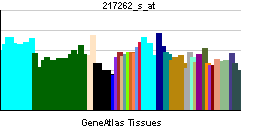CELSR1
| Cadherin, EGF LAG seven-pass G-type receptor 1 (flamingo homolog, Drosophila) | |||||||||||
|---|---|---|---|---|---|---|---|---|---|---|---|
| Identifiers | |||||||||||
| Symbols | CELSR1 ; ME2; CDHF9; DKFZp434P0729; FMI2; HFMI2 | ||||||||||
| External IDs | Template:OMIM5 Template:MGI HomoloGene: 7665 | ||||||||||
| |||||||||||
| RNA expression pattern | |||||||||||
 | |||||||||||
 | |||||||||||
 | |||||||||||
| More reference expression data | |||||||||||
| Orthologs | |||||||||||
| Template:GNF Ortholog box | |||||||||||
| Species | Human | Mouse | |||||||||
| Entrez | n/a | n/a | |||||||||
| Ensembl | n/a | n/a | |||||||||
| UniProt | n/a | n/a | |||||||||
| RefSeq (mRNA) | n/a | n/a | |||||||||
| RefSeq (protein) | n/a | n/a | |||||||||
| Location (UCSC) | n/a | n/a | |||||||||
| PubMed search | n/a | n/a | |||||||||
Cadherin, EGF LAG seven-pass G-type receptor 1 (flamingo homolog, Drosophila), also known as CELSR1, is a human gene.[1]
The protein encoded by this gene is a member of the flamingo subfamily, part of the cadherin superfamily. The flamingo subfamily consists of nonclassic-type cadherins; a subpopulation that does not interact with catenins. The flamingo cadherins are located at the plasma membrane and have nine cadherin domains, seven epidermal growth factor-like repeats and two laminin A G-type repeats in their ectodomain. They also have seven transmembrane domains, a characteristic unique to this subfamily. It is postulated that these proteins are receptors involved in contact-mediated communication, with cadherin domains acting as homophilic binding regions and the EGF-like domains involved in cell adhesion and receptor-ligand interactions. This particular member is a developmentally regulated, neural-specific gene which plays an unspecified role in early embryogenesis.[1]
See also
References
Further reading
- Nollet F, Kools P, van Roy F (2000). "Phylogenetic analysis of the cadherin superfamily allows identification of six major subfamilies besides several solitary members". J. Mol. Biol. 299 (3): 551–72. doi:10.1006/jmbi.2000.3777. PMID 10835267.
- Hadjantonakis AK, Sheward WJ, Harmar AJ; et al. (1997). "Celsr1, a neural-specific gene encoding an unusual seven-pass transmembrane receptor, maps to mouse chromosome 15 and human chromosome 22qter". Genomics. 45 (1): 97–104. doi:10.1006/geno.1997.4892. PMID 9339365.
- Wu Q, Maniatis T (1999). "A striking organization of a large family of human neural cadherin-like cell adhesion genes". Cell. 97 (6): 779–90. PMID 10380929.
- Dunham I, Shimizu N, Roe BA; et al. (1999). "The DNA sequence of human chromosome 22". Nature. 402 (6761): 489–95. doi:10.1038/990031. PMID 10591208.
- Wu Q, Maniatis T (2000). "Large exons encoding multiple ectodomains are a characteristic feature of protocadherin genes". Proc. Natl. Acad. Sci. U.S.A. 97 (7): 3124–9. doi:10.1073/pnas.060027397. PMID 10716726.
- Ghosh A (2000). "Dentritic growth: don't go says flamingo". Neuron. 28 (1): 3–4. PMID 11086974.
- Gross J, Grimm O, Ortega G; et al. (2002). "Mutational analysis of the neuronal cadherin gene CELSR1 and exclusion as a candidate for catatonic schizophrenia in a large family". Psychiatr. Genet. 11 (4): 197–200. PMID 11807409.
- Strausberg RL, Feingold EA, Grouse LH; et al. (2003). "Generation and initial analysis of more than 15,000 full-length human and mouse cDNA sequences". Proc. Natl. Acad. Sci. U.S.A. 99 (26): 16899–903. doi:10.1073/pnas.242603899. PMID 12477932.
- Georgieva L, Nikolov I, Poriazova N; et al. (2004). "Genetic variation in the seven-pass transmembrane cadherin CELSR1: lack of association with schizophrenia". Psychiatr. Genet. 13 (2): 103–6. doi:10.1097/01.ypg.0000057486.14812.03. PMID 12782967.
- Gerhard DS, Wagner L, Feingold EA; et al. (2004). "The status, quality, and expansion of the NIH full-length cDNA project: the Mammalian Gene Collection (MGC)". Genome Res. 14 (10B): 2121–7. doi:10.1101/gr.2596504. PMID 15489334.
- Carroll JS, Liu XS, Brodsky AS; et al. (2005). "Chromosome-wide mapping of estrogen receptor binding reveals long-range regulation requiring the forkhead protein FoxA1". Cell. 122 (1): 33–43. doi:10.1016/j.cell.2005.05.008. PMID 16009131.
This article incorporates text from the United States National Library of Medicine, which is in the public domain.